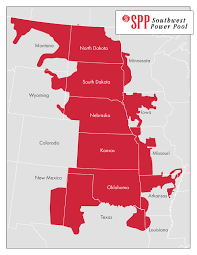
The Southwest Power Pool announced its 2020 Transmission Expansion Plan totaling $545 million to be spent over the next six years on 78 projects in eight states including Oklahoma.
Directors approved the plan on Jan. 28, one that includes an estimated $66 million in projects by OGE, AEP and Western Farmers Electric Cooperative in Oklahoma.
The OGE projects total $13.7 million in improvements at different sites around the state. AEP plans on spending $44 million at sites near Pryor, Sand Springs, Tulsa and Riverside. The $16,288,000 for improvements at Riverside will be the largest of the AEP’s projects.
Western Farmers Electric Cooperative will spend $8,542,000 on improvements at Anadarko, Mooreland, Kingfisher, Gracemont and Marietta. The $5,908,000 to be spent at Marietta will be the largest project.

Of the 78 transmission upgrades approved by SPP’s board, $487 million are new projects while $57 million were upgrades previously covered in a notification to construct (NTC) that was modified last year or were included in a conditional NTC, which SPP uses to request a refined cost estimate for an upgrade without directing the transmission owner to construct any facilities.
Last year, SPP members completed 39 transmission system upgrades in eight states, at an estimated cost of $190 million.
- SPP staff also presented an Electric Storage Resources (ESR) white paper, which noted that batteries and other storage projects can offer “an alternative to traditional transmission facilities” capable of resolving short-term reliability issues such as voltage support and congestion.
- SPP currently considers storage resources on its system only as generators, and there is no estimate of how much money could be saved through a more flexible approach. A spokesperson told Utility Dive that SPP is establishing a steering committee to “delve more deeply into some of these areas.”
- Currently SPP has pumped storage and batteries on its system, but they cannot be classified as transmission resources. In spite of this, representatives of the grid operator say they are “trying to get in front of the ESR flexibility potential to maximize the use of storage in our region.”
Last summer, the grid operator’s interconnection queue consisted of 50 GW of wind, 28.5 GW of solar and 5.7 GW of storage, which led the board to authorize the staff’s white paper on the future impacts of a battery storage buildout.
“Though the ESR white paper mentions ways storage can allay transmission costs, we don’t currently have an estimate of how much those costs might be reduced,” an SPP spokesperson told Utility Dive in an email.
SPP officials say the operator’s Market and Operations Policy Committee is forming a steering committee to address policy questions raised in the storage white paper and other activity is currently underway, including accreditation of storage capacity for resource adequacy.
The Federal Energy Regulatory Commission’s Order 841 directed grid operators to ensure storage can participate in regional transmission organization markets. SPP said it is working with stakeholders to comply with the directive and incorporate storage into its short- and long-term transmission planning and operational processes.
The white paper presented this week by SPP staff noted ESRs can support the reliability of the transmission
grid, possibly allowing the region to avoid costly transmission upgrades.“Storage, when co-located with low-cost generation, can provide an economic energy source for dispatch in SPP’s Integrated Marketplace,” the paper concluded. “The decrease in costs to build ESRs, coupled with recent tax law changes favorable to ESRs, have significantly increased requests to interconnect ESR resources to the transmission grid.”
According to the report, in late 2017, SPP’s generator interconnection queue contained less than 1 GW of ESRs. “By mid-2019, ESR requests had expanded to nearly 7 GW,” the report noted.
The addition of more storage resources “will bring impactful and far-reaching changes,” Richard Dillon, SPP market policy technical director, said in a statement.
Wind was the region’s most utilized energy source in the fourth quarter of 2019 and officials expect the renewable resource will overtake coal as its top energy resource in 2021. Officials note that Oklahoma and Kansas recently experienced multiple days when they produced more wind energy than was needed to serve load for those entire states.
Source: Southwest Power Pool Plan





